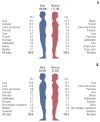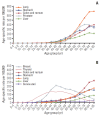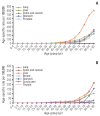Prediction of Cancer Incidence and Mortality in Korea, 2020
- PMID: 32178488
- PMCID: PMC7176954
- DOI: 10.4143/crt.2020.203
Prediction of Cancer Incidence and Mortality in Korea, 2020
Abstract
Purpose: This study aimed to report the projected cancer incidence and mortality for the year 2020 to estimate Korea's current cancer burden.
Materials and methods: Cancer incidence data from 1999 to 2017 were obtained from the Korea National Cancer Incidence Database, and cancer mortality data from 1993 to 2018 were acquired from Statistics Korea. Cancer incidence and mortality were projected by fitting a linear regression model to observed age-specific cancer rates against observed years and then by multiplying the projected age-specific rates by the age-specific population. A Joinpoint regression model was used to determine the year in which the linear trend changed significantly; we only used the data of the latest trend.
Results: In total, 243,263 new cancer cases and 80,546 cancer deaths are expected to occur in Korea in 2020. The most common cancer site is expected to be the lung, followed by the stomach, thyroid, colon/rectum, and breast. These five cancers types are expected to represent half of the overall burden of cancer in Korea. The most common type of cancer among people who die is expected to be lung cancer, followed by liver, colon/rectal, pancreatic, and stomach cancers.
Conclusion: The incidence rates for all types of cancer in Korea are estimated to decrease gradually. These up-to-date estimates of the cancer burden in Korea could be an important resource for planning and evaluating cancer-control programs.
Keywords: 2020; Forecasting; Incidence; Korea; Mortality; Neoplasms.
Conflict of interest statement
Conflict of interest relevant to this article was not reported.
Figures



References
-
- Statistics Korea [Internet] Daejeon: Statistics Korea; 2020. [cited 2020 Feb 8]. Available from: http://kosis.kr.
-
- Fritz A, Percy C, Jack A, Shanmugaratnam K, Sobin L, Parkin DM, et al. International classification of diseases for oncology. 3rd ed. 1st revision. Geneva: World Health Organization; 2013.
-
- World Health Organization . International statistical classification of diseases and related health problems. 10th rev. Geneva: World Health Organization; 1994.
Publication types
MeSH terms
Grants and funding
LinkOut - more resources
Full Text Sources
Medical

